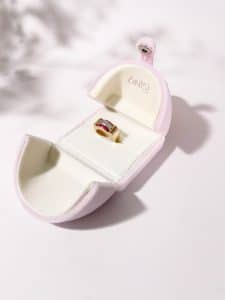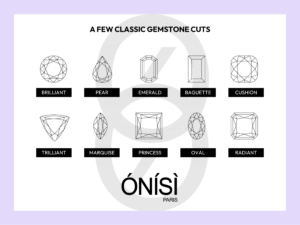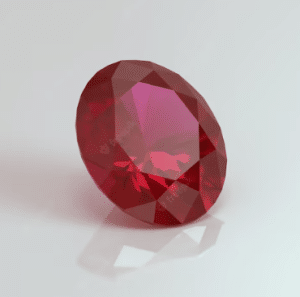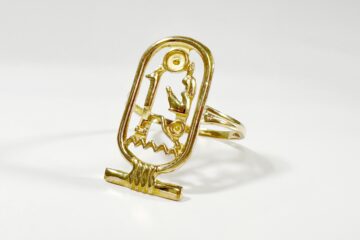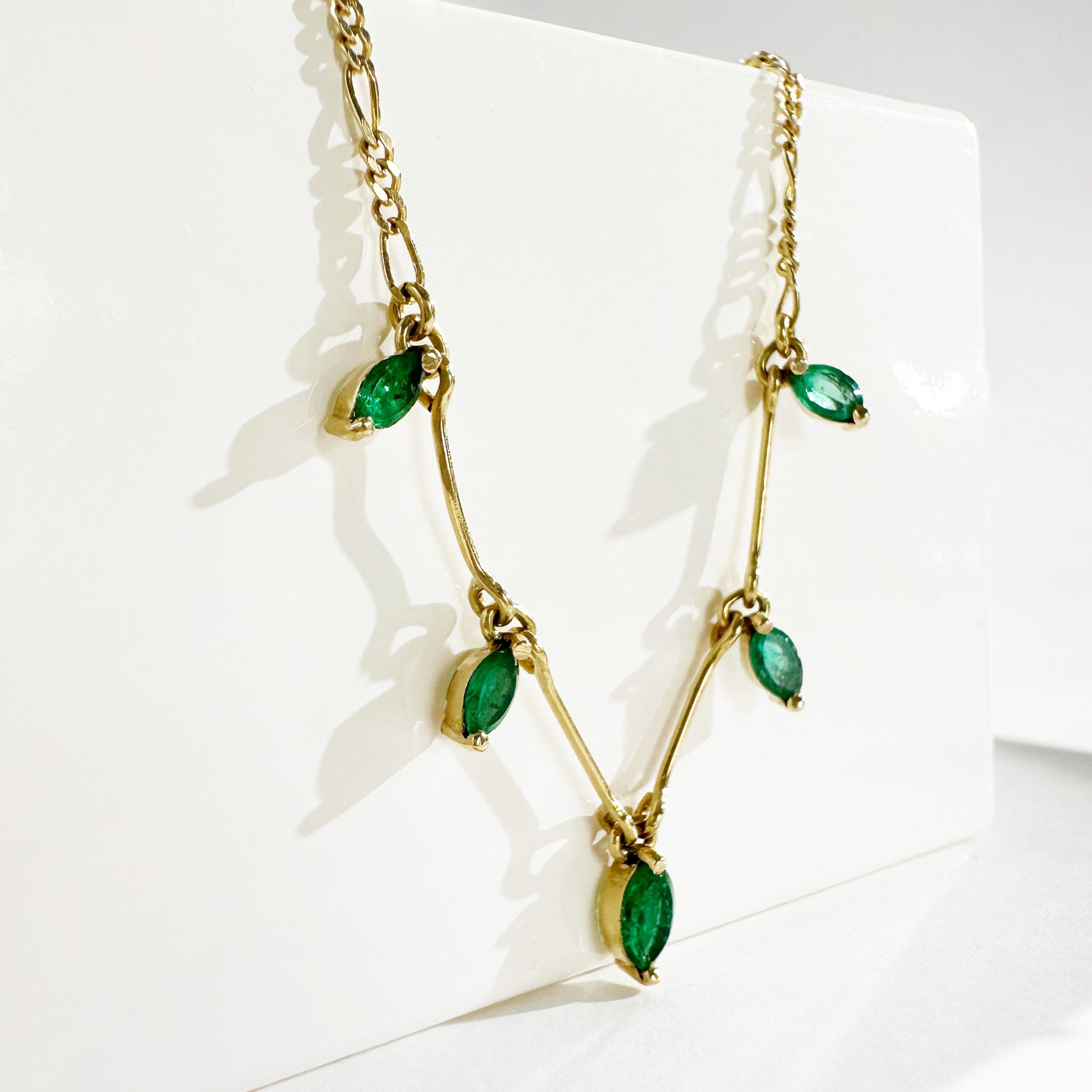If you are new to the antique and vintage jewelry world, it might be a little overwhelming to try and determine how much a piece of jewelry is. Whether it is from a store like ours or from your personal collection, you may not know where to begin to determine the intrinsic value of the jewels. Of course, we precise «intrinsic value » as the value of a piece of history goes well beyond its purely « technical » value.
Although it wouldn’t make sense to give a numeric value for you to gage the price of a piece, as these rapidly change through time, we will give you a guide to have an idea of the range within which the jewelry sits.
1.Determine if it’s actually antique or vintage
This might seem obvious but first and foremost, you need to make sure the piece of jewelry you own is actually antique or vintage. A modern piece of jewelry may not be worth less than an antique one, however, the rules that apply to assess it are not the same.
What do we call antique, vintage, or second hand?

- Vintage starts at the 1940’s and generally ends 20 years before our current times so technically, anything before the years 2000 would be considered vintage.
- Second-hand is thusly used to describe anything from the years 2000 and on.
Although this is not an official definition, it is the most accepted one.
Differentiate original and reproduction
Next, it is also necessary to differentiate between original antique/vintage and reproduction. For instance, although the Art Deco style refers to an era, it also refers to a style that has been reproduced during later eras.
An easy way to tell apart an original from a reproduction is to look at the cut of the stones, and the welding of the piece. Considering that modern techniques of gemstone cutting like lasers did not exist during these antique and vintage eras, a perfectly geometric brilliant cut (modern) is a clear tell that the piece is not an original. In the same way, although the welding on antique piece was exquisite, you will not find antique jewels with perfectly straight, crips angles like it can now be found in modern jewelry.
2. Identify the main alloy
Provided that your piece of jewelry is not costume jewelry, its value will depend on the metal used: is it silver, vermeil, platinum, gold? Its value will increase (or decrease) depending on this information.

Gold titles
The most common case being gold, the second order of business is to determine the title of gold. We have a full article dedicated to gold, from the origin and meaning of the carats to the different hallmarks in the world.
However, to summarize the main idea here, you can remember that although 24 carats is the equivalent of pure gold, it is almost never used in jewelry as it is too soft. It would be too prone to scratches and bending to offer a durable jewel. This is why it is mixed with other metals such as silver, copper and platinum to offer a better hardness and durability.
24 carats being 100% of gold, it is therefore easy to understand that:
- 18 carats is 75% of gold (or 750/1000),
- 9 carats is 37,5% of gold (375/1000)
- And the same logic can be applied to any carats in between.
To determine which carat is your jewelry, you can check the hallmarks, which can be engraved in various places of the piece. For rings it is most often inside the band but for a pendant it can be on the bail, on the pendant, or on the clasp of a necklace. In France, the hallmark for 18-carat gold is an eagle head while is Italy for instance, it is 750 or 18k. You will find all the hallmarks on our article dedicated to gold.
Quite logically, the higher the percentage of gold, the higher the value of the piece of jewelry.
Weight vs gold title
Directly connected to this idea comes the weight of the piece of jewelry: the higher the weight of the piece, the higher the amount of gold and therefore, the higher the value of the piece.
This can explain that a heavy piece of 15 carat gold jewelry might be as valuable or more than a very light, fine piece of 18 carat jewelry. However, for the same weigh, the higher carat will almost always be the most valuable. The only difference could be if the piece of jewelry is signed by a famous designer or of historical importance, for instance.
Of course, when a jewel is set with gemstones, it might be difficult to assess the exact weigh of gold vs the weight of the gemstone. Even though it not perfectly accurate, this information can be inferred since one carat equal 0.2 grams or 200 milligrams. You can therefore use a gemstone chart to give you an idea of the carat weight of your gem based on its size.
Cela nous amène à l’évaluation de la valeur des pierres précieuses dans la section suivante.
3. Evaluate the gemstones (if there are any)

When it comes to antique and vintage gemstones, you can generally use the 4 Cs as a reference, even though it is not as relevant as it is for modern stones. Carat, cut, color and clarity apply better to gemstones that can be evaluated on white paper, meaning unset gems. Indeed, the setting of the jewelry will affect the evaluation of the 4 C’s, as the mounting can interfere with the perception of color or hide inclusions in the stone.
However, the 4 Cs are still a good framework within which you can get an idea of the value of the gemstone. It will become more relevant as the carat size of the stone increases, from 0,5 carat and over.
carat et plus.
Carat
This is the weight of the stone and as mentioned before, one carat equal 0.2 grams. Although it corresponds to a weight, it can be visually assessed, even though you will need to know the density of the stone. Different stones have a different density, so one carat for a diamond will look smaller than one carat for an opal for instance.
Cut
This refers to the shape of the gemstone (cushion, brilliant, emerald, etc.). Provided that the gemstone has been cut correctly (symmetrically and without damaging it), the cut will not affect the price as it is first and foremost a matter of taste.
However, it will allow you to determine the era of the jewelry more easily. We dedicated an entire article to antique diamonds, going through the different cuts through time. The difference is mainly due to the evolution of technology which went from manually cutting stones with hand tools to using lasers for the most precise, optimal cut. Although antique and vintage and gemstones are not as perfect as modern ones, they definitely exude a charm that cannot be replicated by machines as they are all one-of-a-kind.
Color

This will allow to orient the assessment of the gemstone family. However, further specific tests will have to be conducted to identify a stone, as this will directly impact the price of the stone.
For instance, a blue topaze will be less expensive than an aquamarine, although they can look very similar.
The gemstone family being identified, the main criteria to assess a gemstone will be the color saturation. Even though each gemstone has its own specificities, generally, the more vibrant and saturated a gemstone is, the more valuable it will be.
To be vibrant, a gemstone not only need to have an intense color but also to reflect light. This will come down to its clarity, which leads us to our last point.
Clarity
This is simply the number of inclusions or imperfections within a stone. Some gemstones like emeralds always have inclusions and the lack thereof is a tell-tale sign of a synthetic stone. In the case of emeralds, the inclusions even have a name: the garden of the stone. However, in most cases, these imperfections will affect the ability for the stone to reflect light and therefore, its shine.
This, of course, only applies to translucid stones and not opaque ones like opals, coral, or lapis lazuli. These have their own criteria, mainly based on color intensity and specific attributes like their fire in the case of an opal.
4. Identify the design

The idea of using the design of a piece of antique or vintage jewelry to assess its value is relevant in terms of comparison. Indeed, once you know that the piece you are looking is a marquise ring or a pair of dormeuse earrings, you can then start comparing its price with other similar pieces of the same style.
You will of course need all the previously mentioned criteria to fine tune your evaluation, but this will give you a reference point. Of course, a heavy 18kt gold marquise ring set with large, white diamonds of high clarity will not have the same value as a light 18k ring of the same design with smaller, stones with inclusions or a more yellow hue.
With all our jewelry descriptions and Culture Ó articles, you will strengthen your knowledge of antique and vintage designs and learn to know not only how valuable they can be but also how rare they are. This leads us to our final point: rarity.
5. Determine the rarity of the jewelry
The condition
Although even the oldest piece of antique jewelry can be restored to look almost brand new, but the older the piece and the better its condition, the rarer it will be. For instance, the amount of medieval pieces still in circulation is very low. Therefore, finding such a piece, especially in good condition, makes them very rare and very valuable.
The demand
The rareness of a piece of antique jewelry varies through time, notably depending on trends, but you will quickly notice that some design are harder to find than others. Of course, this is a more subjective criteria as you might be looking for a specific design that is not very coveted but very special to you. This will obviously make it more valuable to you and possibly other people with a similar sensibility or story as yours.
However, there can be trends that will make a certain design more coveted at a specific time and therefore, raise its price because of a heightened demand. A good example would be Lady Diana’s marquise sapphire and diamond engagement ring which raised the demand for such rings, both new and antique or vintage, in 1981 and again in 2010 when Kate Middleton was offered the same ring by Prince William.
We hope this article will have helped you to get a proper view of what goes into the value of piece of antique jewelry and how to assess. Make sure to read our other related articles to further you knowledge of the matter!
 en
en
 Français
Français
